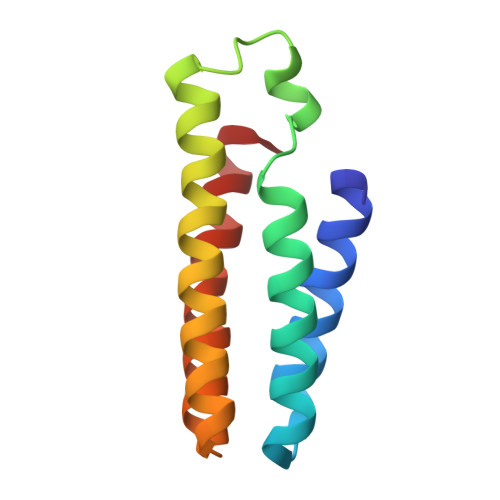Evolution of metal selectivity in templated protein interfaces.
Brodin, J.D., Medina-Morales, A., Ni, T., Salgado, E.N., Ambroggio, X.I., Tezcan, F.A.(2010) J Am Chem Soc 132: 8610-8617
- PubMed: 20515031
- DOI: https://doi.org/10.1021/ja910844n
- Primary Citation of Related Structures:
3IQ5, 3IQ6, 3M79 - PubMed Abstract:
Selective binding by metalloproteins to their cognate metal ions is essential to cellular survival. How proteins originally acquired the ability to selectively bind metals and evolved a diverse array of metal-centered functions despite the availability of only a few metal-coordinating functionalities remains an open question. Using a rational design approach (Metal-Templated Interface Redesign), we describe the transformation of a monomeric electron transfer protein, cytochrome cb(562), into a tetrameric assembly ((C96)RIDC-1(4)) that stably and selectively binds Zn(2+) and displays a metal-dependent conformational change reminiscent of a signaling protein. A thorough analysis of the metal binding properties of (C96)RIDC-1(4) reveals that it can also stably harbor other divalent metals with affinities that rival (Ni(2+)) or even exceed (Cu(2+)) those of Zn(2+) on a per site basis. Nevertheless, this analysis suggests that our templating strategy simultaneously introduces an increased bias toward binding a higher number of Zn(2+) ions (four high affinity sites) versus Cu(2+) or Ni(2+) (two high affinity sites), ultimately leading to the exclusive selectivity of (C96)RIDC-1(4) for Zn(2+) over those ions. More generally, our results indicate that an initial metal-driven nucleation event followed by the formation of a stable protein architecture around the metal provides a straightforward path for generating structural and functional diversity.
Organizational Affiliation:
Department of Chemistry and Biochemistry, University of California, San Diego, La Jolla, California 92093-0356, USA.















